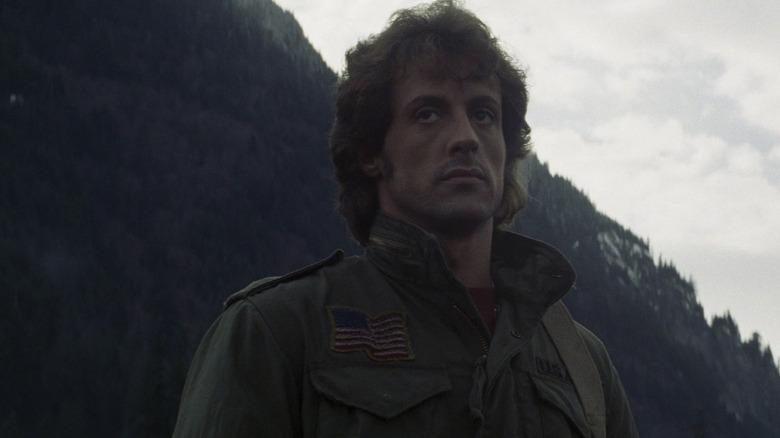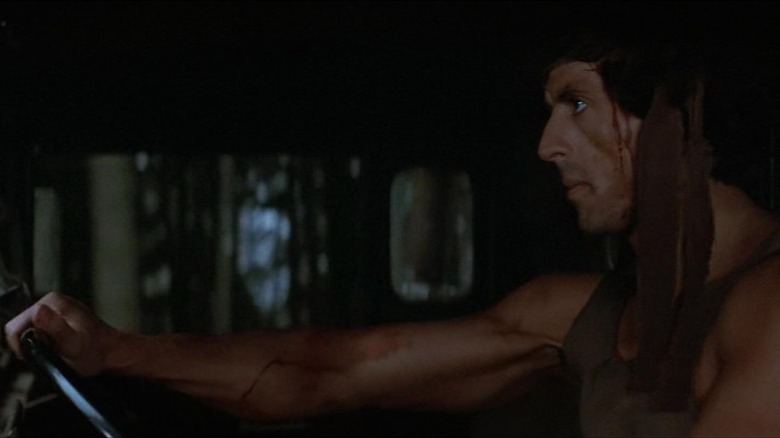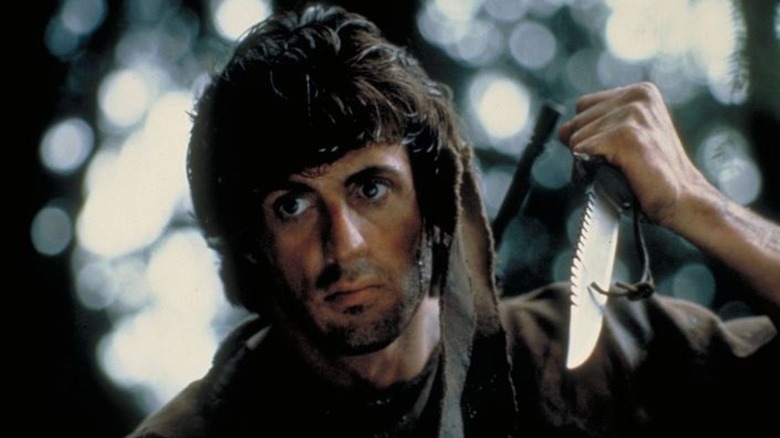Rambo's Success Had An 'Embarrassing' Side Effect On Sylvester Stallone
In 1982's "First Blood," Sylvester Stallone stars as John Rambo, a Vietnam War veteran who single-handedly goes to war with the fictional small town of Hope, Washington. Though it's not stated in the movie, it's obvious Rambo suffers from a severe case of post-traumatic stress disorder, which is accentuated by flashbacks of being tortured as a prisoner of war during the scene in which the local officers arrest and torment him in jail. These flashbacks prompts Rambo to go into survivalist combat mode.
Based on David Morrell's 1972 novel of the same name, the movie is a compelling commentary on the damaging effects Vietnam had on U.S. soldiers who felt mistreated upon their return home from the war. "First Blood" is a perfect mix of action, storytelling, and emotion, which is why it's my favorite action film. Sadly, I can't say the same for the 1985 sequel, which follows the protagonist as he single-handedly rescues a group of POWs from Southeast Asia. "Rambo: First Blood II" manages to transform Rambo from a sympathetic, misunderstood man traumatized by a war condemned as needless by many Americans into a guns-blazing hero.
Nevertheless, the success of the sequel was an even bigger box office hit than the original. It solidified Stallone, who was primarily known for his "Rocky" movies, as the biggest action star of the time, and made the Rambo character a pop culture icon referenced by even Ronald Reagan. "Boy, after seeing 'Rambo' last night, I know what to do the next time this happens," the then-U.S. President joked of a solution to a real-life hostage crisis, according to The L.A. Times. For Stallone, this exploding popularity came at an embarrassing cost.
Machine gun-toting Rambo toys for kids
Because the musclebound Rambo had been transformed into an American heroic figure in "Rambo: First Blood Part II," the character had major potential as a toy. Consequentially, a surge of Rambo action figures equipped with machine guns and other military-style weapons flooded the market. "I couldn't control it," Sylvester Stallone told the late Chicago Tribune movie critic Gene Siskel in '86. ”I tried to stop it, but I don't own the licensing rights."
Stallone told Siskel that months prior, during the holidays, he was asked to give away a "truckload" of these Rambo toys to sick children in the hospital. ”I told 'em, 'Get this ... the hell out of my driveway and burn it. Don't give it away,'" he said. ”It's not for kids. The movie was not supposed to be for little kids, and I wouldn't let my own children play with those toys." The toys were heavily scrutinized, and Stallone was "very embarrassed" by the whole ordeal as he felt he was being blamed for a side effect he no part in creating. The experience made him decide to control the merchandising of his films going forward. But the toys weren't the end of his embarrassment.
Rambo: The Force of Freedom
In September '86, "Rambo: The Force of Freedom," an animated series for children, premiered on television. The show was met with controversy in the months leading up to its first episode. National publications cited a then-recent study from the National Institute of Mental Health that directly correlated violent behavior among children with ”excessive” violence on television. Parents and critics alike feared the show would send the wrong message to kids. The producers of the show contended otherwise. Amy Kastens, a spokeswoman for the producers, told The New York Times: ”When you think that the President has mentioned him, the symbol of Rambo transcends the film. That symbol is a symbol of good. He's very patriotic. He stands for strength, he only does good, and he undoes evil.”
The show, which began as a five-part miniseries and later evolved into a daily cartoon, portrays a subdued version of the central character who does good deeds and exudes much less violence than character from the R-rated films. Of course, the existence of the show meant more Rambo toys, which all continued to irk Stallone.
"First of all, that isn't Rambo," he told Siskel, referring to the watered down version of character. "But, more important, they tell me I can't stop them because it's not me their using; it's a likeness of a character I played and don't own.” Lucky for Stallone, the show lasted only one season.


